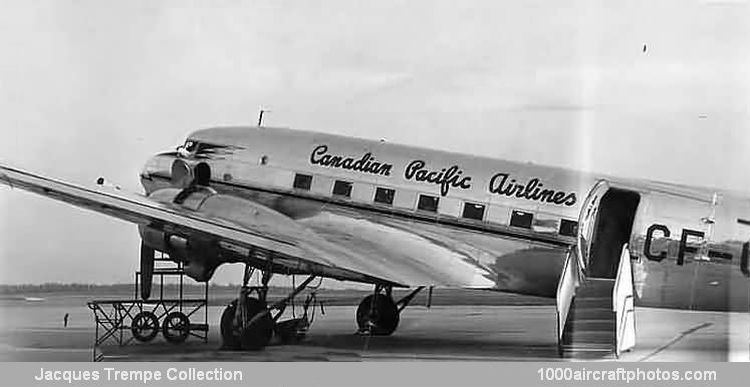02/28/2011. Remarks by Jack McKillop: "This Douglas Model DC-3A-360 was ordered by the USAAF as C-47-DL s/n 41-18456 and delivered on July 13, 1942. By October 1942, it was assigned to the 4th Troop Carrier Squadron, 62rd Troop Carrier Group at Keevil, Wiltshire, England. The group had been designated as one of the units participating in the invasion of Northwest Africa in November 1942. On November 15, 1942, the group moved to Algeria and then to Tunisia in July 1943. The group then operated from bases in Sicily and Italy between September 1943 and November 1945 when it was inactivated.
During this period, the group dropped British paratroopers to attack German airdromes in Tunisia in November 1942, towed gliders and dropped paratroopers during the invasion of Sicily in July 1943, dropped paratroopers in northern Italy in June 1944 to harass the retreating Germans, towed gliders and dropped paratroopers during the invasion of southern France in August 1944 and during the Allied assault on Greece in October 1944.
Declared surplus, it was transferred to the Reconstruction Finance Corp. for disposal and was sold to Canadian Pacific Airlines of Vancouver, British Columbia, Canada on August 31, 1946. After conversion to a civil DC-3C, the aircraft was registered CF-CUA on February 6, 1947 and assigned fleet number 280.
In Canada's first act of air terrorism, this aircraft exploded over the small town of Sault-au-Cochon, Quebec on a flight from Quebec City to Baie Comeau on September 9, 1949. Sault-au-Cochon is located about 40 mls (64 km) northeast of Quebec City. The crash killed all nineteen passengers and four crew on board.
It did not take long for authorities to ascertain that the explosion was the result of a time bomb in the forward luggage compartment, making the crash of the DC-3 the third episode of in-flight terrorism in the world, and the deadliest at the time.
The investigation centered on three people: Albert Guay, husband of Rita Morel Guay, a passenger on the airplane, Marguerite Pitre of Quebec City, and Genereux Ruest, an employee and friend of Albert Guay. Guay opened a jewelry shop after WW II ended and though neighbors and acquaintances stated that Alberta made a show of embracing Rita in public, the marriage was not a happy one and things only got worse after their only child was born. Albert was jealous and possessive, in debt, and struggling to keep the jewelry business afloat.
In 1948 Guay met Marie-Ange Robitaille, a 17-year-old night-club waitress, and Albert soon fell in love with her. Using the name of Roger Angers, he bought Marie-Ange an engagement ring, but his wife found out about the affair and confronted the couple in the Robitaille home. Marie-Ange's parents had no idea that Albert was married and threw their daughter out of the house. Divorce was out of the question, and so Guay determined to murder his wife.
Guay enlisted the help of Genereux Ruest, his employee and close friend. Together, they learned how to build a time bomb from twenty sticks of dynamite, an alarm clock and a battery.
Guay persuaded his wife that it was imperative that she go to Baie Comeau to retrieve some jewels that he had bought for his jewelry and watch-repair business. She was very unwilling to go and, in fact, argued with Albert in the airport. He insisted that she go as he had already bought the ticket. At the same time, Guay had also invested in a CDN$10,000 (CDN$97,355 in 2011 dollars) life insurance policy on his wife.
The same morning that the Guay's were arguing over the trip to Baie Comeau, a woman arrived at the airport with a heavy parcel that she wished shipped to Baie Comeau. Her name was Marguerite Pitre and she was a sister of the girlfriend. When questioned by police, Marguerite said that she had been given the package by Albert Guay, and that she didn't know what was in it.
Ten days later Marguerite Pitre attempted suicide by taking an overdose of sleeping pills. She told the police that Guay had come to her house and told her that the package she had shipped contained the bomb. He also encouraged her to commit suicide as she would be blamed for the explosion.
Guay was arrested on September 23, 1949 and charged with murdering his wife. He was found guilty in February 1950. When he imposed the death sentence, the trial judge stated: 'Your crime is infamous: it has no name.'
Both Ruest and Pitre were also sentenced to death. Marguerite maintained her innocence until the Supreme Court of Canada rejected her claim. She was hung on January 9, 1953, the last woman executed in Canada."
